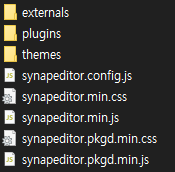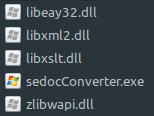RELEASE 2.2.0 OR ABOVE
1. Installation
SynapEditor installation package is comprised of the following components.
- SynapEditor + Import Module
- SynapEditor_2.x.x.zip
- Fonts for metafile conversion
- fonts.zip
Copy the installation file to the desired path and decompress the zip file.
*In this Guide, we copy the file into /workspace and decompress the zip file. Explanations are based on the assumption that /workspace is located in WEB ROOT.
When you decompress the SynapEditor_2.x.x.zip file, the following path is generated.
| Path | Content | Explanation |
|---|---|---|
/workspace/SynapEditor_2.x.x/SynapEditor | externals : External module directory plugins : Plugin directory theme : theme directory license.json : License file synapeditor.config.js : Configuration file synapeditor.min.css, synapedtiro.min.js : SynapEditor synapeditor.pkgd.min.css, synapeditor.pkgd.min.js : SynapEditor including plugins | |
| /workspace/SynapEditor_2.x.x/sedocConverter | Windows Linux | Import module (execution file) Windows : sedocConverter.exe and multiple dll files Linux : sedocConverter_exe |
Decompress fonts.zip file under /workspace.
| Path | Explanation |
|---|---|
/workspace/fonts | Font file used to convert metafiles (wmf/emf) during document import |
2. Configuration
2.1 License Configuration
Open the synapeditor.config.js file and designate the path for license.json file. The path for license.json file should be accessible via the browser.
{
/**
* Set up the path or object for the license file
* ex) '/synapeditor/license.json'
* ex) {
'company': 'Synapsoft',
'key': [
'licenseKey'
]
}
*/
'editor.license': 'synapeditor/license.json',
...
}
3. 3. Initializing SynapEditor and Saving Edited Contents
Incorporating SynapEditor into your own environment is also very simple and straightforward.
You can use either <div> or <textarea> tag for the instantiation of SynapEditor.
3.1 Using <div> tag
3.1.1 Include js and css file for SynapEditor with <script> and <link> tags
<link href='synapeditor/synapeditor.min.css' rel='stylesheet' type='text/css'> <script src='synapeditor/synapeditor.config.js'></script> <script src='synapeditor/synapeditor.min.js'></script>
3.1.2 Create new SynapEditor instance using <div> tag
<!DOCTYPE html>
<html lang="ko">
<head>
<meta charset="utf-8">
<meta http-equiv="X-UA-Compatible" content="IE=edge">
<meta name="viewport" content="width=device-width, initial-scale=1.0, minimum-scale=1.0, maximum-scale=1.0, user-scalable=no, shrink-to-fit=no">
<title>Synap Editor | Unlimited Rich Text Editor</title>
<link href="synapeditor/synapeditor.min.css" rel="stylesheet" type="text/css">
<script src="synapeditor/synapeditor.config.js"></script>
<script src="synapeditor/synapeditor.min.js"></script>
<script>
function initEditor() {
var se = new SynapEditor("synapEditor", synapEditorConfig);
}
</script>
<body onload="initEditor();">
<div id="synapEditor"></div>
</body>
</html>
3.1.3 Save edited content by POSTing HTML form
This example uses jQuery to send POST request.
<!DOCTYPE html>
<html lang="ko">
<head>
<meta charset="utf-8">
<meta http-equiv="X-UA-Compatible" content="IE=edge">
<meta name="viewport" content="width=device-width, initial-scale=1.0, minimum-scale=1.0, maximum-scale=1.0, user-scalable=no, shrink-to-fit=no">
<title>Synap Editor | Unlimited Rich Text Editor</title>
<link href="synapeditor/synapeditor.min.css" rel="stylesheet" type="text/css">
<script src="https://code.jquery.com/jquery-3.3.1.js"></script>
<script src="synapeditor/synapeditor.config.js"></script>
<script src="synapeditor/synapeditor.min.js"></script>
<script>
$(document).ready(function() {
var se = new SynapEditor("synapEditor", synapEditorConfig);
$('#seform').on('submit', function() {
$('#editor').val( se.getPublishingHtml() );
return true;
});
});
</script>
<body>
<div id="synapEditor"></div>
<form id="seform" name="seform" action="/save" method="post">
<textarea id="editor" style="display:none"></textarea>
<input type="submit" value="SAVE"/>
</form>
</body>
</html>
3.2 Using <textarea> tag
3.2.1 Include script and css file for SynapEditor with <script> and <link> tags
<link href='synapeditor/synapeditor.min.css' rel='stylesheet' type='text/css'> <script src='synapeditor/synapeditor.config.js'></script> <script src='synapeditor/synapeditor.min.js'></script>
3.2.2 Create new SynapEditor instance using <textarea> tag
<!DOCTYPE html>
<html lang="ko">
<head>
<meta charset="utf-8">
<meta http-equiv="X-UA-Compatible" content="IE=edge">
<meta name="viewport" content="width=device-width, initial-scale=1.0, minimum-scale=1.0, maximum-scale=1.0, user-scalable=no, shrink-to-fit=no">
<title>Synap Editor | Unlimited Rich Text Editor</title>
<link href="synapeditor/synapeditor.min.css" rel="stylesheet" type="text/css">
<script src="synapeditor/synapeditor.config.js"></script>
<script src="synapeditor/synapeditor.min.js"></script>
<script>
function initEditor() {
var se = new SynapEditor("synapEditor", synapEditorConfig);
}
</script>
<body onload="initEditor();">
<textarea id="synapEditor"></textarea>
</body>
</html>
3.2.3 Save edited content by POSTing HTML form
This example uses jQuery to send POST request.
<!DOCTYPE html>
<html lang="ko">
<head>
<meta charset="utf-8">
<meta http-equiv="X-UA-Compatible" content="IE=edge">
<meta name="viewport" content="width=device-width, initial-scale=1.0, minimum-scale=1.0, maximum-scale=1.0, user-scalable=no, shrink-to-fit=no">
<title>Synap Editor | Unlimited Rich Text Editor</title>
<link href="synapeditor/synapeditor.min.css" rel="stylesheet" type="text/css">
<script src="https://code.jquery.com/jquery-3.3.1.js"></script>
<script src="synapeditor/synapeditor.config.js"></script>
<script src="synapeditor/synapeditor.min.js"></script>
<script>
$(document).ready(function() {
var se = new SynapEditor("synapEditor", synapEditorConfig);
});
</script>
<body>
<form id="seform" name="seform" action="/save" method="post">
<textarea id="synapEditor"></textarea>
<input type="submit" value="SAVE"/>
</form>
</body>
</html>
4. Applying Plugins and External Modules
You can add the various plugins provided by SynapEditor as follows.
Please refer to Plugin page for more detailed information.
Loading Plugins
<!-- Note) Plugin files shall be created under SynapEditor file.-->
<!-- SynapEditor File-->
<link rel="stylesheet" href="../synapeditor.min.css">
<script src="../synapeditor.min.js"></script>
<!-- Plugin File-->
<link rel="stylesheet" href="../plugins/webAccessibilityChecker/webAccessibilityChecker.min.css">
<script src="../plugins/webAccessibilityChecker/webAccessibilityChecker.min.js"></script>
Generating Plugin UI
<script>
new SynapEditor('ID of HTML element to initialize the Editor', {
//...
'editor.toolbar': [
//...
'webAccessibilityChecker' //If you wish to expose the buttons provided by a plugin, use the name provided by the plugin for the name of UI, just as the exsiting Editor configurations.
//...
]
//...
});
</script>
Applying External Modules
Apply external modules like Code Mirror etc. to enjoy more powerful editing features.
| External Module | 용도 |
|---|---|
| CodeMirror | 소스코드를 더 예쁘게 보여주고 편리하게 편집 할 수 있습니다. |
| formulaParser | 에디터의 표에서 엑셀 함수를 사용할 수 있도록 기능을 확장합니다. |
| SEDocModelParser | hwp, doc, docx, xls, xlsx 문서를 임포트할 수 있도록 기능을 확장합니다. |
| SEShapeManager | 도형이 포함된 문서에 대한 임포트 및 도형표인이 가능하도록 기능을 확장합니다. 도형편집 플러그인을 사용하시려면 이 모듈을 꼭 적용해야 합니다. |
Please refer to External Module page for more detailed information.
Example of applying plugins and external modules
<!DOCTYPE html>
<html lang="ko">
<head>
<meta charset="utf-8">
<meta http-equiv="X-UA-Compatible" content="IE=edge">
<meta name="viewport" content="width=device-width, initial-scale=1.0, minimum-scale=1.0, maximum-scale=1.0, user-scalable=no, shrink-to-fit=no">
<title>Synap Editor | Unlimited Rich Text Editor</title>
<!-- Synap Editor -->
<link href="synapeditor/synapeditor.min.css" rel="stylesheet" type="text/css">
<script src="synapeditor/synapeditor.config.js"></script>
<script src="synapeditor/synapeditor.min.js"></script>
<!-- Synap Editor Plugins -->
<!-- Personal Data Protection -->
<script src="synapeditor/plugins/personalDataProtection/personalDataProtection.min.js"></script>
<link rel="stylesheet" href="synapeditor/plugins/personalDataProtection/personalDataProtection.min.css">
<!-- Special Character/Emoji -->
<script src="synapeditor/plugins/characterPicker/characterPicker.min.js"></script>
<link rel="stylesheet" href="synapeditor/plugins/characterPicker/characterPicker.min.css">
<!-- Photo Editor -->
<script src="synapeditor/plugins/tuiImageEditor/tuiImageEditor.min.js"></script>
<link rel="stylesheet" href="synapeditor/plugins/tuiImageEditor/tuiImageEditor.min.css">
<!-- Web Accessibility Checker -->
<script src="synapeditor/plugins/webAccessibilityChecker/webAccessibilityChecker.min.min.js"></script>
<link rel="stylesheet" href="synapeditor/plugins/webAccessibilityChecker/webAccessibilityChecker.min.min.css">
<!-- horizontalLine Extension -->
<script src="synapeditor/plugins/horizontalLineExtension/horizontalLineExtension.min.min.js"></script>
<link rel="stylesheet" href="synapeditor/plugins/webAccessibilityChecker/webAccessibilityChecker.min.min.css">
<!-- quote Extension -->
<script src="synapeditor/plugins/quoteExtension/quoteExtension.min.min.js"></script>
<link rel="stylesheet" href="synapeditor/plugins/quoteExtension/quoteExtension.min.min.css">
<!-- Synap Editor Externals -->
<script type="text/javascript" src='synapeditor/externals/formulaParser/formula-parser.min.js'></script>
<script type="text/javascript" src='synapeditor/externals/SEDocModelParser/SEDocModelParser.min.js'></script>
<script type="text/javascript" src='synapeditor/externals/SEShapeManager/SEShapeManager.min.js'></script>
<!-- CodeMirror -->
<script type="text/javascript" src='synapeditor/externals/codeMirror/codemirror.min.js'></script>
<script type="text/javascript" src="synapeditor/externals/codeMirror/xml.min.js"></script>
<link rel='stylesheet' href='synapeditor/externals/codeMirror/codemirror.min.css'>
<script>
function initEditor() {
var se = new SynapEditor("synapEditor", synapEditorConfig);
}
</script>
<body onload="initEditor();">
<div id="synapEditor"></div>
</body>
</html>
{
'editor.toolbar': [
//...,
'personalDataProtection',
'specialCharacter', 'emoji',
'tuiImageEditor',
'WebAccessibilityChecker',
//...
],
}
4. Import API and Upload API Configuration
Set the import and upload API path to the configuration file for file (image, video, ...) upload and document (doc, docx, xls, xlsx) import.
APIs(/importDoc, /uploadImage, /uploadVideo, /uploadFIle) required for Import and upload should be implemented in Back-end. Please refer to Server Connection Manual.
{
'editor.import.api': '/importDoc',
'editor.upload.image.api': '/uploadImage',
'editor.upload.video.api': '/uploadVideo',
'editor.upload.file.api': '/uploadFile',
...
}
Please refer to Configuration page for more detailed information regarding other settings including other menu and toolbar properties.

